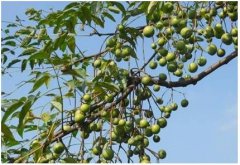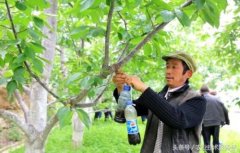The use of wood vinegar in agriculture: the use of wood vinegar and the usage of wood vinegar
Manufacture and use of wood vinegar: what are the uses of wood vinegar in agriculture? Do you know the use and usage of wood vinegar? Let's take a look at it.

The use of wood vinegar
The main component of wood vinegar is vinegar, in addition, there are more than 100 other ingredients, some good and bad, its effect is roughly the same as vinegar, but more than vinegar, mainly due to the different kinds of nutrients or natural pesticides added, and its effect is also different. when in use, it is sugar wood vinegar if it is mixed with black sugar enzyme solution.
1. General purpose:
(1) Medical raw materials.
(2) Feed additive.
(3) solvent of acetone, acetic acid lime, etc.
(4) deodorant.
(5) mordant.
(6) Wood preservatives.
(7) Food preservatives.
(8) sewage purifying agent.
two。 Agricultural uses:
The main results are as follows: (1) improve the vitality of crop roots and leaves, slow down aging, reduce fruit acidity, prolong fruit storage time and improve fruit flavor.
(2) to control some diseases and insect pests on soil and leaves and promote the reproduction of soil beneficial microorganisms.
(3) increase the effect of pesticides.
(4) accelerate the fermentation rate of composting.
(5) eliminate the stench of livestock and poultry feces and urine.
(6) adding feed to improve meat quality.
Manufacture of wood vinegar
1. Manufacturing method of wood vinegar:
(1) charcoal kiln method: all kinds of miscellaneous wood branches and unused branches of orchards are braised in the charcoal kiln to produce smoke so that the natural gas condenses into liquid, which is of good quality. however, coniferous trees with high resin, Casuarina equisetifolia and waste furniture containing paint shall not be used.
(2) Rice oven method: the manufacturing method is simple and convenient, the main raw materials can be rice husk or bagasse, first fill the rice husk in the furnace, and then put a mass of waste paper in the center of the upper section, ignite, so that after the rice husk is on fire, the liquid flows to the lower outlet of the chimney and flows into the collection bucket to become crude wood vinegar. The stove made of gasoline can fill about 20 kilograms of rice husk, usually about a day, and the rice husk can be roughly burned in about a day. When the liquid is no longer discharged, open the lid, pour out the residue, spray water to turn it off and become fumigated charcoal. If the burning time is too long, the residue becomes rice husk ash, that is, the fumigated charcoal cannot be collected.
(3) mixing method: the method of stewing and distillation of a small amount of branches and rice husks together.
two。 Purification of crude wood vinegar:
The newly made wood vinegar belongs to crude wood vinegar. It should be placed for more than six months so that the precipitation is divided into three layers. The top layer is light oil. Try to remove it as far as possible, and then pour out the middle layer of crude wood vinegar, leaving the lowest layer of tar. After standing for six months, the crude wood vinegar is first given to Lu and then poured into 3-4% charcoal powder or 2% activated carbon, fully mixed, placed for one day and then given to the green, that is, the refined wood vinegar is clear and golden yellow or yellowish brown. The remaining light oil, tar, and used charcoal or activated carbon can also be collected as soil improvement or fruit tree coating materials for pest control.
3. Identification criteria of wood vinegar:
(1) A brown to tea-brown and transparent liquid without sediment.
(2) ph2.5-3.0.
(3) the proportion of Baume is 1.5-3.0.
(4) resin tar less than 1%.
The use of wood vinegar
1. Apply to the soil
The main results are as follows: (1) to control nematode and bacterial wilt: 10-30 times for open space and 30-50 times for opening holes in the inner edge of the crown.
(2) Irrigation to the soil during the growth period: use 100,200 times, irrigation to the depths of 50cm.
(3) use charcoal shavings after absorption: use 50-30 times so that charcoal shavings are fully absorbed and applied to soil or mixed with compost.
(4) use after composting: use 100 times.
two。 Spread over the leaves:
The leaf surface of sugar and wood vinegar is scattered, rice can be sprayed with black sugar enzyme and wood vinegar, and sprayed from the middle stage. General crops, including vegetables, flowers, fruit trees, etc., and sensitive crops such as watermelon, cantaloupe, cantaloupe, towel gourd, clematis, papaya and grapefruit use about 800-1000 times. Pears should avoid using high concentration wood vinegar before bagging to avoid harming the pericarp. Onions and garlic are easy to die when using wood vinegar. So don't use it. Before flowering, some sprays such as calcium phosphate, potassium phosphate, boric acid and cytokines can be added to inhibit flower bud differentiation and improve fruit setting rate. In the young fruit stage, appropriate addition of fish essence, amino acid, seaweed essence, milk powder, comprehensive microorganisms or trace elements can promote fruit hypertrophy, but nitrogen materials such as fish essence and amino acid should be stopped in the middle and later stage. instead, monocalcium phosphate, potassium phosphate, calcium lactate, magnesium heavy phosphate and manganese sulfate were used to increase sugar content and reduce fruit acidity. If there are diseases and insect pests, soak garlic, pepper, tobacco, houttuynia, neem, wormwood, citronella, peppermint, other materials such as seaweed essence, citronella oil, peppermint oil, neem oil, summer oil, comprehensive beneficial microorganisms, thuria, etc. can be added to improve its effect, as for alkaline materials such as lime sulfur mixture, lime Bordeaux solution, arsenic agent, soap and so on can not be used.
3. Deodorization of livestock feces and urine: use 50 times irrigation until thoroughly drenched.
4. Added to livestock feed:
Adding 1% to rice bran or rapeseed meal as feed can enhance meat color, reduce moisture and prevent mastitis, but wood vinegar for feed should be kept for at least one year and can only be used after distillation and other special treatment.
- Prev

Neem: can neem seed extract kill insects? Is neem oil effective in killing insects?
Have you heard of neem insecticides? This is an insecticide made from insecticidal ingredients extracted from plants. The development and use of neem insecticides seems to have become a world trend. I can see that neem has been used as a road tree in some places in Thailand and flower markets around the country.
- Next

How to prepare sweet and sour liquid what is the proportion of sweet and sour liquid formula? What is the function of sweet and sour liquid?
Sugar and vinegar solution: foliar spraying sugar and vinegar can prevent diseases and insect pests and freeze injury. After spraying vinegar solution on the leaves of crops, the acidity of the leaves can be increased, and then the diseases and insect pests which are not suitable for acid conditions can be inhibited or killed, and the control effect can be achieved. According to observation and research, bacterial diseases in crops
Related
- A one-day flower show brings 130 million yuan in orders! Nanhai, this Phalaenopsis exhibition is amazing
- What do the flower language and meaning of Lutheran tree mean? Precautions for planting Lutheran tree
- Encounter Chaoshan Kongfu tea, not without this cup of Phoenix single clump
- The durian market in Vietnam and Thailand is flooded. The price of imported durian has plummeted by 30-40% in a month.
- Shanghai solved the problem of local vegetable supply by planting 80,000 mu of green leafy vegetables.
- Wageningen University has become the best agricultural university in the world for the seventh time in a row.
- The strongest export season of South African grapes is full of challenges, with exports to Russia falling sharply by 21%.
- Sri Lanka is on the verge of bankruptcy, "Tea for debt" Organic Agriculture Revolution aggravates the Food crisis?
- Turning waste into earthworm manure and worm manure into organic fertilizer-A new choice for auxiliary farming
- Organic rice growers shoulder the responsibility of nurturing agricultural talents! Yinchuan Sustainable Farm with Organic Life Camp

